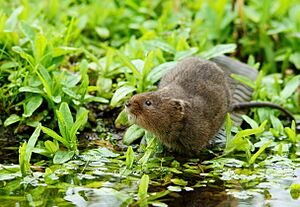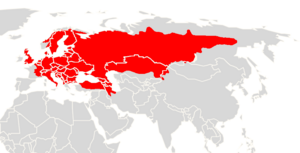European water vole facts for kids
The European water vole (Arvicola amphibius) is a small animal that lives near water. It's a type of rodent, like a mouse or a rat. People sometimes call it a "water rat," but it's not a true rat. Water voles have rounder noses, deep brown fur, chubby faces, and short, fuzzy ears. Unlike rats, their tails, paws, and ears are covered with hair.
In the wild, water voles usually live for about five months. If they live in a safe place like a zoo, they can live up to two and a half years.
Quick facts for kids European water vole |
|
|---|---|
 |
|
| Conservation status | |
| Scientific classification | |
| Genus: |
Arvicola
|
| Species: |
amphibius
|
 |
|
| Synonyms | |
|
Arvicola terrestris (Linnaeus, 1758) |
|
Contents
What Does a Water Vole Look Like?
Water voles grow to be about 14 to 22 centimeters (5.5 to 8.7 inches) long. Their tail is about half the length of their body. Adult water voles can weigh from 60 to 140 grams (2.1 to 4.9 ounces). Some very large ones can weigh up to 386 grams (13.6 ounces). To survive winter and have babies, females need to weigh at least 112 grams (4 ounces). Males need to weigh at least 115 grams (4.1 ounces).
European water voles are usually a dark brown color. Their fur is a bit lighter on their belly. They have thick fur all over their body, even on their tail. This is different from rats. Their dark color helps them hide in the plants where they live.
The Water Vole's Scientific Name
The scientific name for the European water vole is Arvicola amphibius. For a long time, it was called A. terrestris. This happened because Carl Linnaeus, a famous scientist, described two types of water voles on the same page. Later, scientists realized they were the same animal. The name A. amphibius was chosen as the correct one.
Some people used to think the southwestern water vole was the same species. But now, most scientists agree they are different.
Where Do Water Voles Live?
The European water vole (Arvicola amphibius) can be found in most parts of Europe. They also live in Russia, West Asia, and Kazakhstan.
Water Vole Homes and Habitats

In Britain, water voles dig burrows in the banks of rivers, ditches, ponds, and streams. They like calm, slow-moving water. They also build ball-shaped nests above ground in reed beds if there are no good banks for burrows.
Water voles prefer lots of plants along the water's edge. These plants help them hide from predators when they are out of their burrows. They usually avoid areas where plants are heavily eaten or trampled. They also don't like areas with too many trees, preferring open wetland places.
Besides typical wetlands, water voles also live in upland areas. They use small ditches, rivers, and lakes surrounded by moorland. They can live at heights up to 1,000 meters (3,280 feet) in places like northern Scotland.
In Europe and Russia, water voles sometimes go into woods, fields, and gardens. They can live under the snow during winter.
Water voles are being brought back to places like Yorkshire, England, because their numbers have dropped. However, in some parts of France, farmers are worried about too many water voles. Large numbers of them can damage crops.
What Do Water Voles Eat?
Water voles mostly eat grass and other plants that grow near water. They also eat fruits, bulbs, twigs, buds, and roots when they can find them. Sometimes, when there's a lot of food, water voles can have "plagues." This means there are huge numbers of them. They eat a lot, destroying whole fields of grass and filling them with burrows. In some parts of England, water voles have been seen eating frogs and tadpoles. Scientists think they might do this to get more protein in their diet.
Just finding leftover food isn't always enough to know if water voles are there. Other smaller voles can also leave behind parts of large grasses.
How Water Voles Have Babies
Water voles mate from March until late autumn. The female water vole is pregnant for about 21 days. She can have up to 8 baby voles at a time. Each baby weighs around 10 grams (0.35 ounces) when born. The young voles open their eyes three days after they are born. By the time they stop drinking their mother's milk, they are half the size of an adult water vole.
Water Vole Behavior
Water voles are very good at swimming and diving. They usually do not live in big groups. Each adult water vole has its own territory. They mark their territory with their droppings, which they leave near their nest or burrow. They also leave droppings on platforms at the water's edge where they get in and out of the water. Finding these droppings is a good way to know if water voles are in an area. They also mark their territory with a special scent from their bodies. If another water vole enters their territory, they might attack it.
Who Hunts Water Voles?
Many animals hunt European water voles because they are a common rodent. However, many predators prefer other small rodents, like different types of voles or wood mice. This is because there are usually more of those animals around.
Some animals that hunt water voles include wildcats, red foxes, and many types of hawks and owls. Falcons, especially the common kestrel, also hunt them. A very large number of water voles are also caught by mustelids. These are animals like small weasels and mink. European mink and American mink (which were brought to Europe) might hunt the most water voles. This is because they like to live in the same watery places. The American mink population has grown a lot and is not controlled. This has caused the number of water voles to go down in Britain.
Protecting Water Voles
In the United Kingdom
On February 26, 2008, the U.K. Government announced that water voles would get full legal protection starting April 6, 2008. This means it's against the law to harm them or their homes.
Water voles have recently returned to the Lindow Common nature reserve in Cheshire, England. They had been gone for many years.
In 2015, the People's Trust for Endangered Species started a new project. It helps organize efforts to protect water voles in the U.K. This project, called the National Water-Vole Monitoring Programme (NWVMP), is the first ongoing way to keep track of water voles in the U.K. It collects information from many places to see how the animals are doing each year.
In September 2019, the Box Moor Trust released 177 water voles into the River Bulbourne in Hemel Hempstead. This was part of a three-year plan to help their numbers grow.
Water Voles in Books and Songs
A water vole named "Ratty" is a main character in the 1908 children's book The Wind in the Willows by Kenneth Grahame. The place in the book is thought to be Moor Copse in Berkshire, England. The character's name "Ratty" made many people think of water voles living by rivers. It also led to the idea that they are a type of rat, which isn't true.
In the funny novel and film Cold Comfort Farm by Stella Gibbons, a character named Urk calls the girl he likes, Elfine Starkadder, his "little water-vole." Urk spends a lot of time talking to the water voles on the farm.
Charles Stuart Calverley, a writer from the 1800s, wrote a poem called "Shelter." It talks about a shy young female by a lake. At the end of the poem, it's revealed that "she was a water-rat."
The Rolling Stones song "Live With Me" includes a line about a friend who interacts with water voles near water.
Images for kids






